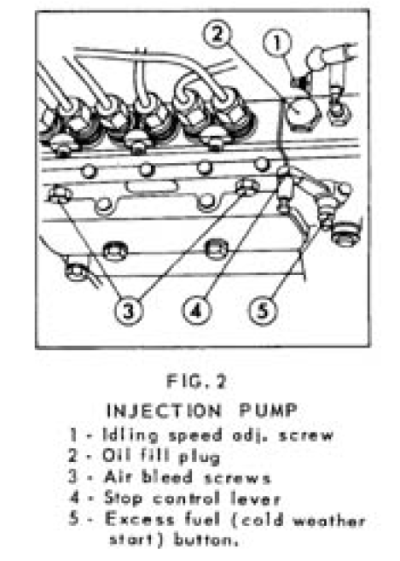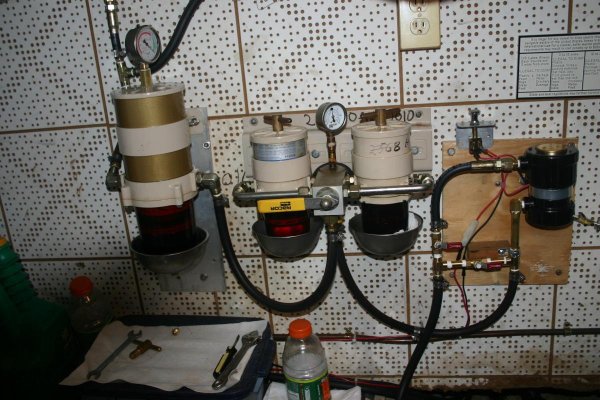Capt. Rodbone
Senior Member
- Joined
- Sep 6, 2020
- Messages
- 177
- Location
- U.S.
- Vessel Name
- SV Stella Polaris MV Sea Turtle
- Vessel Make
- 1978 VanDine Gaff rigged schooner, 1978 Grand Banks Classic Trawler
It didn’t take long for us to resume our loop trip and experience an issue. I’ll share what I think are relevant details and what I’ve done and hopefully get some suggestions.
Two weeks ago changed all three fuel filters on each engine as well as oil filters. I ran four hours 10 days ago with no issues. Ran four hours yesterday before the issue. Did top off fuel between the two trips. Also used biocide. Together the tanks hold about 480 gallons and it took exactly 100 gallons to top off. Tanks were plumbed together when we bought the boat and I have not segregated them as of yet.
Lost port engine just prior to entering Whitton Lock on the Tombigbee waterway. Secured shaft with a pipe wrench and continued on and while in the lock started looking for alternatives as my wife wasn’t comfortable driving with me down in the engine room in her just now getting used to the boat. Got lucky as there is Midway Marina 5 miles down river. Continued on with one engine. Didn’t expect to get practice so soon on running this boat on one engine but no issues at the lock or getting to the dock at Midway.
This morning I read up and watched one more refresher video on changing the primary fuel filter however it is my first time doing so solo.
I will spare the details on exactly what I did given it is a relatively simple process. I did fill the canister up to the very top before securing the lid and opening fuel flow since I had read that may keep me from having to prime. It did not, so I opened the nut on the top of the first secondary filter and started priming. Considerable bubbles at first which I saw to be great news. Kept pumping pumping secured the nut tried to start the engine no joy. Repeated the process three times never saw any more bubbles, but she also doesn’t start. I’m wondering if there is a reason to go ahead and change out secondary filters even though again they’ve got less than 10 hours on them. Starting to think it’s no coincidence that we took on fuel between the two four hour runs and wondering if something was stirred up in the tank. If that is the case, that is a harder thing to remedy. We can’t get a mechanic if one is needed to look at this engine until Monday anyway so if wisdom here says yes the next thing you need to do is change your secondary filters I will do so.
Just looking for experienced wisdom and thoughts from you folks.
Two weeks ago changed all three fuel filters on each engine as well as oil filters. I ran four hours 10 days ago with no issues. Ran four hours yesterday before the issue. Did top off fuel between the two trips. Also used biocide. Together the tanks hold about 480 gallons and it took exactly 100 gallons to top off. Tanks were plumbed together when we bought the boat and I have not segregated them as of yet.
Lost port engine just prior to entering Whitton Lock on the Tombigbee waterway. Secured shaft with a pipe wrench and continued on and while in the lock started looking for alternatives as my wife wasn’t comfortable driving with me down in the engine room in her just now getting used to the boat. Got lucky as there is Midway Marina 5 miles down river. Continued on with one engine. Didn’t expect to get practice so soon on running this boat on one engine but no issues at the lock or getting to the dock at Midway.
This morning I read up and watched one more refresher video on changing the primary fuel filter however it is my first time doing so solo.
I will spare the details on exactly what I did given it is a relatively simple process. I did fill the canister up to the very top before securing the lid and opening fuel flow since I had read that may keep me from having to prime. It did not, so I opened the nut on the top of the first secondary filter and started priming. Considerable bubbles at first which I saw to be great news. Kept pumping pumping secured the nut tried to start the engine no joy. Repeated the process three times never saw any more bubbles, but she also doesn’t start. I’m wondering if there is a reason to go ahead and change out secondary filters even though again they’ve got less than 10 hours on them. Starting to think it’s no coincidence that we took on fuel between the two four hour runs and wondering if something was stirred up in the tank. If that is the case, that is a harder thing to remedy. We can’t get a mechanic if one is needed to look at this engine until Monday anyway so if wisdom here says yes the next thing you need to do is change your secondary filters I will do so.
Just looking for experienced wisdom and thoughts from you folks.


